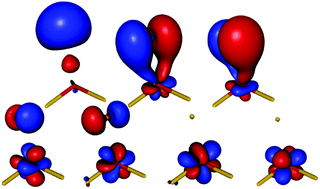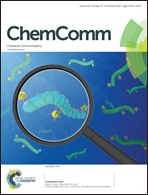Post Hartree–Fock calculations of pnictogen–uranium bonding in EUF3 (E = N–Bi)†
Abstract
NUF3 is identified as having a N![[triple bond, length as m-dash]](https://www.rsc.org/images/entities/char_e002.gif) U triple bond, as has been previously found (Andrews et al., Angew. Chem. Int. Ed., 2008, 47, 5366). By contrast, while previously reported calculations on PUF3 and AsUF3 (Andrews et al., Inorg. Chem., 2009, 48, 6594) gave a E
U triple bond, as has been previously found (Andrews et al., Angew. Chem. Int. Ed., 2008, 47, 5366). By contrast, while previously reported calculations on PUF3 and AsUF3 (Andrews et al., Inorg. Chem., 2009, 48, 6594) gave a E![[triple bond, length as m-dash]](https://www.rsc.org/images/entities/char_e002.gif) U triple bond, our calculations suggest a single bond for both molecules, with antibonding π* and non-bonding 5fU orbitals significantly occupied, and highly multiconfigurational wavefunctions. We propose this difference to be due to the smaller [6,6] active space used (σ, π, π* and σ*) in the previous studies. In our calculations, a [6,16] active space was employed in order to include uranium f-orbitals and pnictogen d-orbitals.
U triple bond, our calculations suggest a single bond for both molecules, with antibonding π* and non-bonding 5fU orbitals significantly occupied, and highly multiconfigurational wavefunctions. We propose this difference to be due to the smaller [6,6] active space used (σ, π, π* and σ*) in the previous studies. In our calculations, a [6,16] active space was employed in order to include uranium f-orbitals and pnictogen d-orbitals.

- This article is part of the themed collection: New molecules and materials from the f-block


 Please wait while we load your content...
Please wait while we load your content...